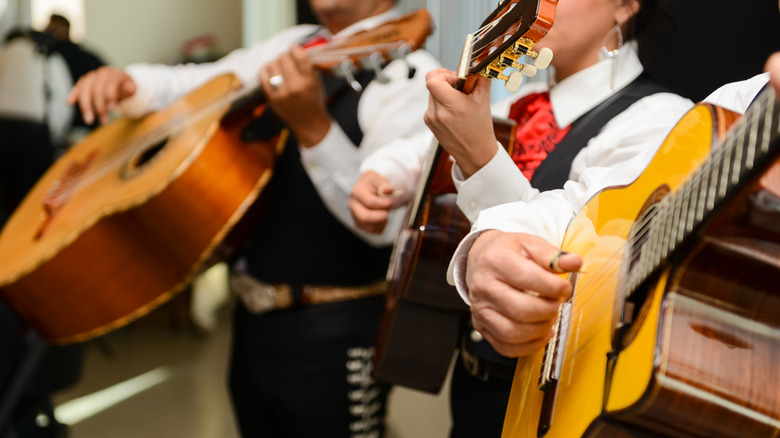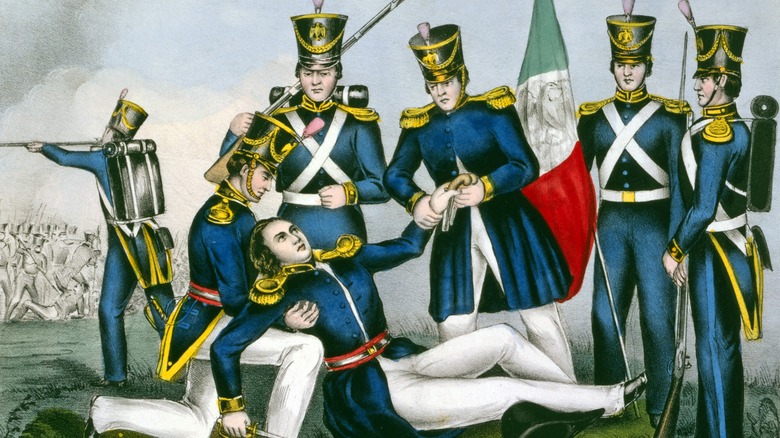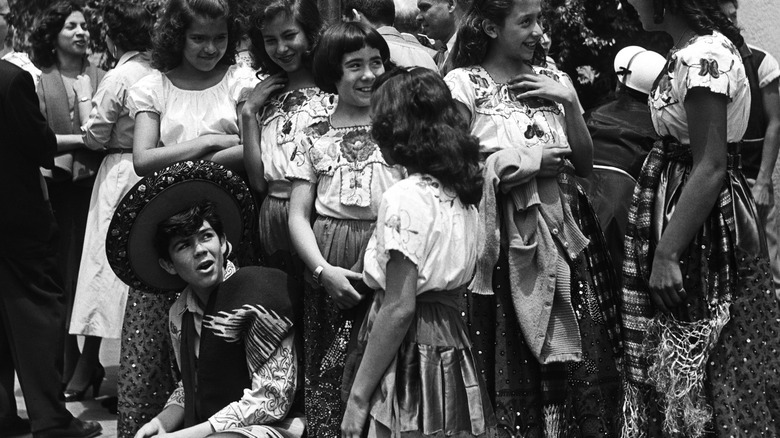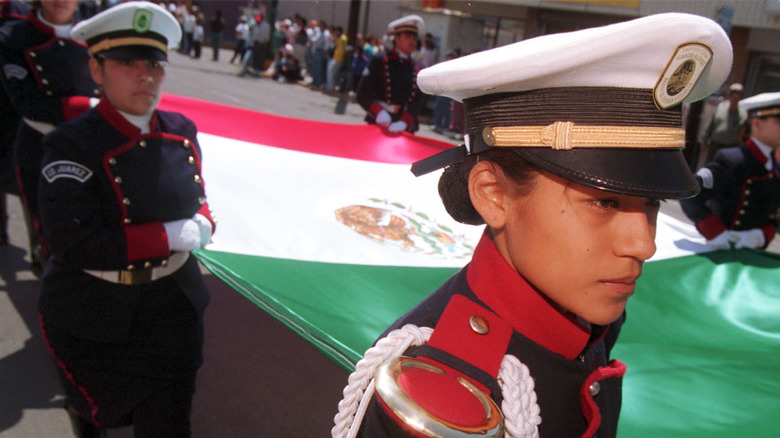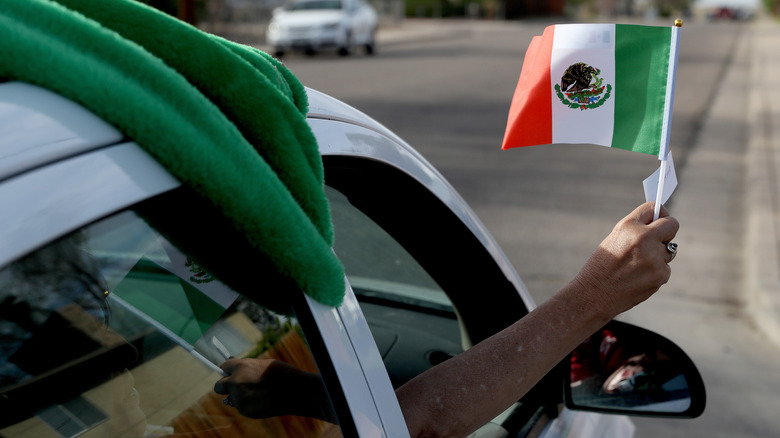The Real Reason The US Celebrates Cinco De Mayo
In many parts of the U.S., Cinco de Mayo, or May 5, is nothing more than an excuse to drink some margaritas and enjoy some Mexican food. It's commonly seen as a kind of Mexican equivalent to America's Fourth of July, celebrating Mexico's independence from Spain, but that's not the case; Mexican Independence is September 16, per National Today. What's certainly true, though, is that Cinco de Mayo is deeply rooted in war and Mexican history. And the real reason we celebrate Cinco de Mayo in the U.S. is not what you might expect, as History explains.
To present the full picture of what the Cinco de Mayo holiday means and why the holiday itself has become so popular in the U.S., it's important to remember the long history of colonization and European intervention that has been experienced in Mexico. Mexico's colonization by Spain is well known. Less well known, perhaps, is the country's troubled relationship with France.
The Second Franco-Mexican War
The Second Franco-Mexican war took place between 1862 and 1867, according to the U.S. Department of State's Office of the Historian. At this point, France, under French Emperor Napoleon III, had installed a puppet Mexican emperor named Maximilian of Habsburg, Archduke of Austria (pictured). A history of civil war and other economic and social disruptions had left Mexico in debt to France and Spain (per Napoleon, the history website of the Foundation Napoleon).
Around that same time, a coalition of Franco-Spanish forces came to collect what was owed. In 1862, French troops engaged with Mexican forces at the Battle of Puebla, but were rebuffed. The resistance that French forces met at the time was unexpected. Although the city would not fall to France at that point, Mexico did later lose control of the city. That early victory, though, went down in Mexican history, and so, too, did the date when happened: May 5.
The Mexican-American War
This brings us somewhat closer to understanding what Cinco de Mayo means in Mexico, but how did the holiday make its way to America? That question brings up, in part, another military conflict that occurred earlier than the Second Franco-Mexican War, this time with the U.S. The Mexican-American War began in 1846, and it was largely fought over Texas, which had gained independence from Mexico 10 years prior, according to History.
At that point, the western edge of the United States had bumped up against territory still held by Mexico, including Texas and other large parts of the desert southwest. America wanted its hand on that land, and after two years of fighting would not only take control of Texas, but also California, among other areas north of the Rio Grande River. Mexicans living in those areas were now suddenly Mexican-Americans. Even though the U.S. government promised to treat them as equals, that turned out not to be true, as USA Today reports.
An act of resistance
Following the Mexican victory at the Battle of Puebla in 1862, and as immigration back and forth between the Southern U.S. and Mexico remained steady, word of the Cinco de Mayo holiday spread. Many Mexican-Americans still living in those areas identified with their Mexican heritage, and were increasingly displeased with their treatment as American citizens. For this reason, Cinco de Mayo was adopted by those still living in this region as a point of pride and as an act of resistance to American influence, according to USA Today.
Cinco de Mayo is traditionally not just an excuse to wear sombreros and drink tequila each spring, but instead, a symbol of Mexican perseverance, as associate professor of Chicana and Chicano Studies at California State University, Fullerton Alexandro Gradilla, told USA Today. "They began to celebrate that holiday because they also wanted to commemorate their acts of resistance during the U.S.-Mexico war, but also holding their own after incorporation ... The fact that you had Mexican communities in the southwest celebrating Cinco de Mayo was very powerful and very symbolic," Gradilla said.
Cinco de Mayo in Mexico
According to Britannica, celebrating Cinco de Mayo is a much smaller affair in Mexico than it is in the U.S. The occasion is primarily marked in and around Puebla, where the Mexican victory took place in 1862. Certain areas of Mexico don't celebrate it at all. Some examples of Cinco de Mayo celebrations in Mexico include school closures in Puebla, as well as a parade with participants dressed in 19th-century period French and Mexican military attire, as well as floats, Mariachi music, and other attractions, as Mexico Daily Post explains.
Other aspects of Cinco de Mayo festivities in Puebla, just two hours from Mexico City and the country's fourth-largest population center, include the International Mole Festival, which celebrates mole, a type of sauce and marinade that is one of Mexico's most iconic dishes. Some who grew up in Mexico report observing the date with their families, as they prepare and share meals together, dance the "Jarabe Tapatio" — the Mexican hat dance — and pray for their ancestors. The true meaning of the date is never far from their memory, according to USA Today.
Cinco de May comes to America
Per USA Today, though, Cinco de Mayo has been increasingly popular throughout the U.S. since the mid-20th century. It is now largely commercialized, a trend which has become controversial. And even though it's not an official holiday, Cinco de Mayo these days is celebrated among American citizens as much as it is among those of Mexican-American ancestry. The date is now seen in the U.S. as a time to partake in icons of Mexican culture like piñatas, music, clothing, and Mexican cuisine, although much of that food is highly Americanized.
Some of the largest American Cinco de Mayo celebrations occur in Los Angeles, Albuquerque, Phoenix, and El Paso, among many other large population centers throughout the southwest. As can be seen, the true origins of Cinco de Mayo are far from what the true meaning of the date represents in Mexico, or to fellow Americans of Mexican-American heritage. These are just a few things to remember if you celebrate Cinco de Mayo, this year and in years going forward.
